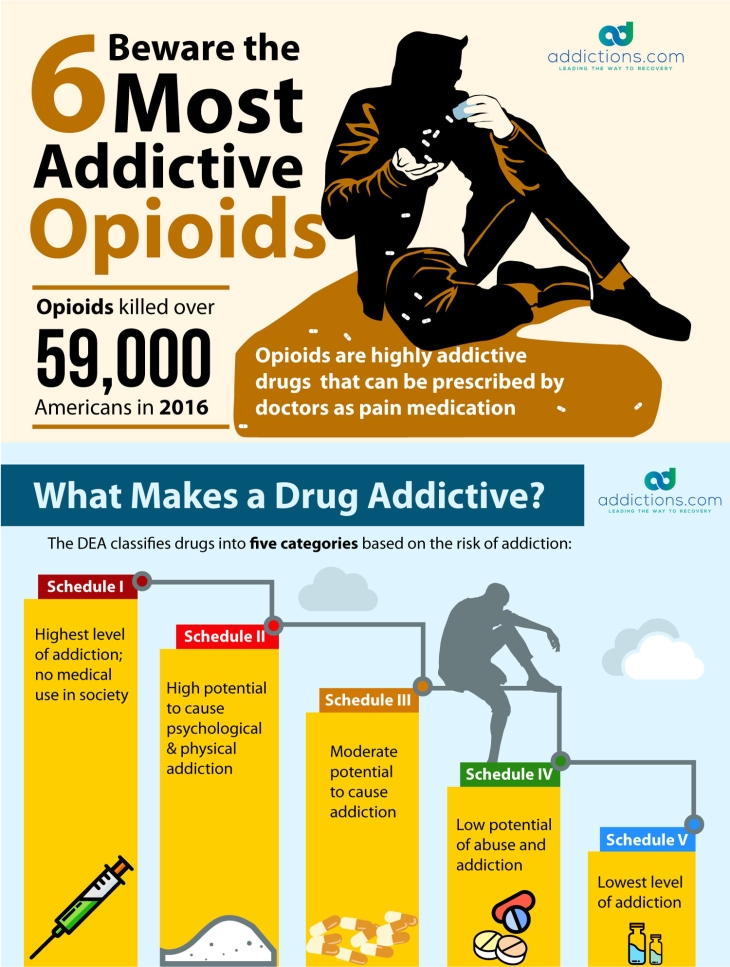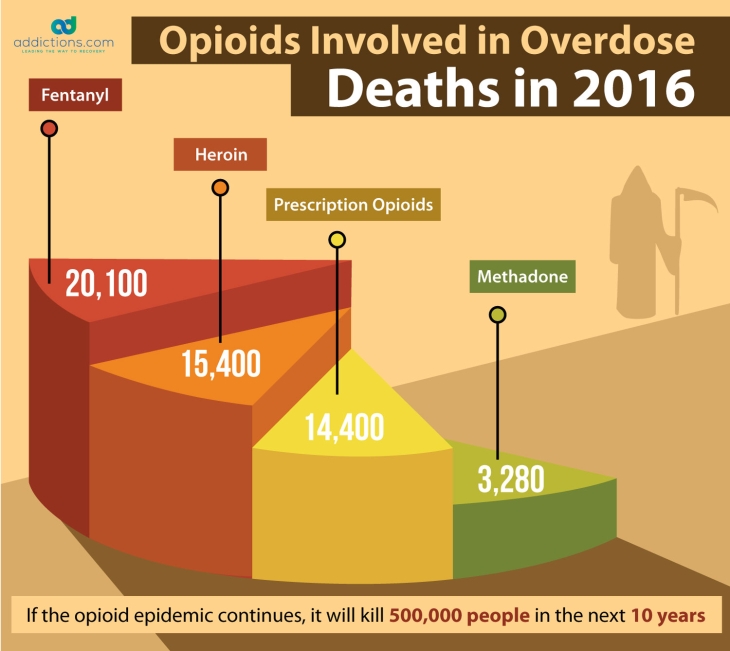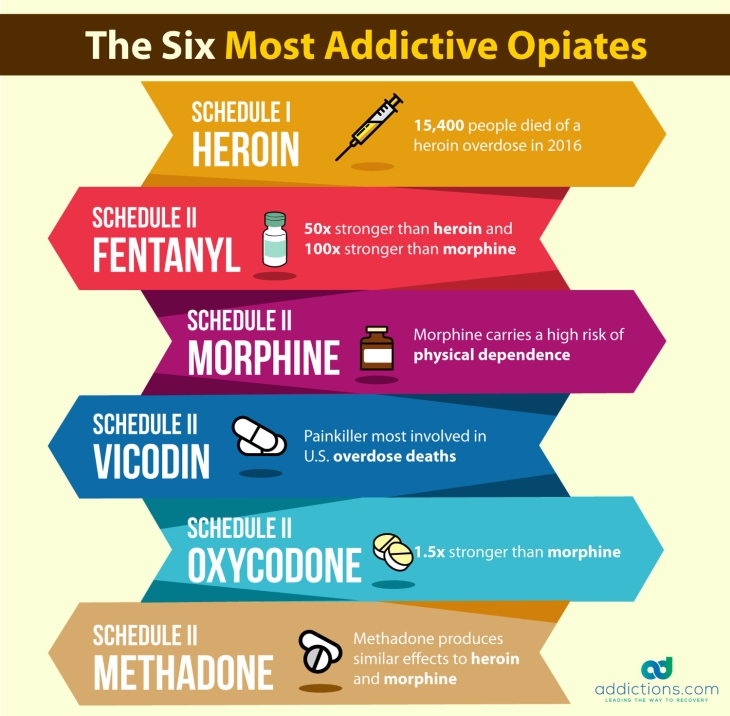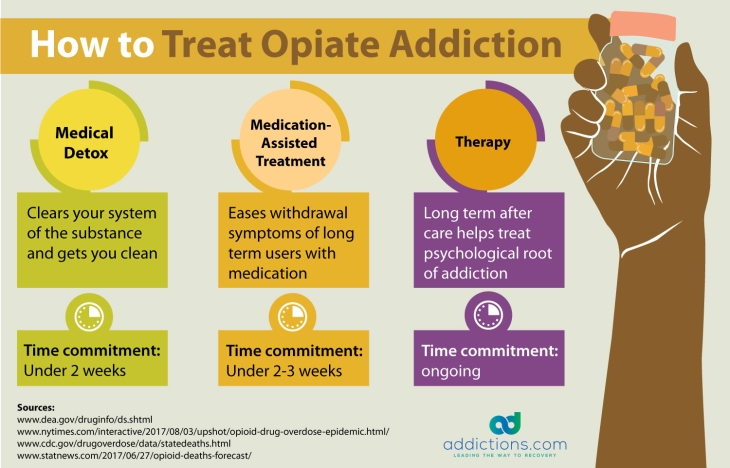Heroin is widely known as the most addictive drug in the entire world, and falls under the opioid drug class. Fentanyl caused more than 20,000 overdose deaths in the U.S. in 2016, and is also an opioid. Opioids carry an especially high risk for dependence and addiction, and can cause many long-term side effects related to your health, career, relationships, and overall livelihood.
Knowing about America’s most powerful, addictive opiates can help you and your loved ones avoid the onset of addiction amidst the country’s deadly ongoing opioid crisis.
Here’s a list of the six most addictive opiates, and what you can do if you or a loved one needs help fighting opiate addiction.

What are Opioids?
Opioids, also known as opiates, painkillers, and narcotics, are commonly prescribed to treat moderate to severe pain. Though many opioids are prescribed by doctors, these substances are highly dangerous and can lead to an overdose when misused. Heroin is the most commonly used illicit opioid that can be purchased from the streets in most U.S. cities for as little as $15 per dose.
Opioids are derived from the opium plant, which is native to many parts of Asia. Opioids work by binding to opioid receptors throughout the brain and central nervous system that control feelings of pain, pleasure, and reward. The effects of opioids include pain relief, sedation, relaxation, and euphoria.
Opioids are used to treat severe pain such as that caused by injury, surgery, and certain cancer treatments. These drugs are typically only prescribed for a short-term basis, since using the drugs long-term can lead to tolerance, dependence, and addiction. Opioid use in the U.S. has become a nationwide crisis and public health emergency, and caused more than 53,000 deaths in 2016.
How Addictive are Opioids?
Heroin and pain pills are ranked among the top ten most addictive drugs in the world. Evidence shows that opioid dependence can occur as soon as three days after someone starts using the drugs. The risk for dependence and addiction increases more substantially for those who use opioids for five days or longer.

The U.S. opioid epidemic is being driven in part by doctors’ prescribing practices surrounding painkillers. In states like Tennessee and Alabama, there are enough opioid prescriptions written to put pills in the hands of every state resident, including children. Many doctors also tend to prescribe more painkillers than needed, resulting in extra pills being stored in medicine cabinets across the country.
Surveys show that over 50 percent of people who abuse painkillers receive the pills from friends and relatives for free, while over 22 percent receive the pills from their doctors. Many Americans assume opioids are safe to use since they’re prescribed by doctors and pharmacists, and remain unaware of their addictive potential.
Opiate addiction can lead to loss of employment, poor academic performance, loss of relationships, and more. Opiate addiction is also linked to a lower life expectancy, and can cause a range of serious long-term health problems.
Long-term health effects linked to opiate addiction:
- Nausea and vomiting
- Abdominal bloating
- Constipation
- Weakened immunity
- Insomnia
- Brain damage
- Liver damage
- Kidney disease
- Respiratory illness
- Depression
- Anxiety
Many of these health problems can be improved or reversed within several months or years after overcoming opioid dependency. Withdrawing from opioids is safest when conducted in a professional medical setting to lower the risk for possible complications and side effects linked to certain withdrawal symptoms.
Addiction to Prescription Opioids
Prescription opioids have been used medicinally in the U.S. to treat pain since before the 20th century. But addiction to prescription opioids didn’t become problematic in the U.S. until the mid-1990s, when oxycodone was marketed and sold as OxyContin by Purdue Pharma. Shortly after the drug’s release, Purdue used a number of aggressive marketing techniques to raise awareness about OxyContin and its medical uses among prescribers and patients.
Today, there are roughly 1.9 million Americans diagnosed with painkiller use disorder, and 4.3 million Americans who report using painkillers for nonmedical reasons.
Prescription opioids list:
- Codeine
- Hydrocodone
- Morphine
- Oxycodone
- Meperidine
- Hydromorphone
- Tramadol
- Methadone
- Fentanyl
Addiction to Illicit Opioids
Heroin was used in the U.S. during the early 20th century to treat pain until doctors started noticing patients were abusing the drug and becoming dependent. Heroin was officially declared an illicit substance in 1924 under the Anti-Heroin Act.
Illicit opioid use in the U.S. is rising on behalf of the opioid epidemic. People who can no longer afford painkillers or obtain prescriptions from their doctors often start using illicit opioids since these drugs are lower in cost and easier to obtain. Those who become tolerant and dependent on painkillers are also likely to start using illicit opioids, since these drugs tend to have higher potency levels.
Surveys show that 4.8 million Americans have used heroin at some point in their lives, and that 435,000 Americans are regular users of heroin.
Illicit opioids list:
- Heroin
- Fentanyl analogues
- U-47700, or Pink
- Carfentanil
- Opium
- Other synthetic opioids
Synthetic opioids are highly dangerous, and often contain compounds and substances that are not safe or meant for human ingestion. Drugs like fentanyl and carfentanil have even triggered accidental overdoses in first responders who care for victims at overdose scenes. Many times, heroin is mixed or cut with other illicit opioids that can cause an instant overdose.
The Six Most Addictive Opioids
Before you or your loved ones start using opioids for any reason, familiarize yourself with the following six opiates. These substances carry a high risk for addiction. Opioid addiction can be prevented by avoiding illicit opiates, and using prescription opiates responsibly and correctly.
Here are the six most addictive opiates driving the U.S. opioid epidemic.

1. Heroin
Heroin was created in 1895 as an alternative to morphine, and was meant to produce no adverse side effects. But the drug was banned in the U.S. nearly 30 years later when doctors learned that heroin put patients at high risk for dependence, addiction, and other serious health complications.
Heroin is fast- and short-acting, meaning effects begin quickly within minutes, and wear off after just a few hours. This illicit opioid is addictive for that very reason, since users will continue taking doses repeatedly throughout the day in an effort to achieve lasting euphoria.
Heroin use in the U.S. has risen dramatically since the onset of the opioid epidemic. Heroin-related overdose deaths have more than quadrupled since 2010, with three out of every four heroin users reporting having abused painkillers before switching to heroin.
2. Fentanyl
Fentanyl is currently the strongest, most powerful opioid used in U.S. medicine. Created during the 1960s, fentanyl is up to 50 times stronger than heroin, and up to 100 times stronger than morphine. Fentanyl caused more than 20,000 overdose deaths in 2016 — just 0.25 mg of fentanyl can lead to a fatal overdose.
Fentanyl is fast- and short-acting just like heroin, and is favored among heroin users for its similar effects. Fentanyl analogues, or street fentanyl, are drugs made of synthetic, modified fentanyl compounds, and often contain other dangerous chemicals. Many heroin dealers cut or mix their supplies with fentanyl analogues since these substances are less costly and known to produce a stronger high.
Fentanyl is defined a Schedule II drug by the DEA, which means the drug carries a high risk for abuse, dependence, and addiction. The DEA recently announced its plans to define fentanyl analogues as Schedule I drugs alongside heroin, since these dangerous substances have no accepted medical use and carry a high potential for abuse, addiction, and death.
3. Morphine
Morphine is a naturally occurring substance that comes directly from the opium poppy. Americans started using morphine during the 19th century to relieve pain for soldiers who suffered injuries during the American Civil War.
This Schedule II drug can be crushed, snorted, smoked, or administered orally and intravenously. Common brand names for morphine are Kadian, Roxanol, MSiR, MS-Contin, and Oramorph.
4. Vicodin
Vicodin is the brand name for the combination of hydrocodone and acetaminophen. Hydrocodone is an opioid, while acetaminophen is a non-opioid pain reliever that helps reduce fever. Hydrocodone mimics the effects of morphine to offer pain relief and sedation.
Vicodin was defined a Schedule III drug until 2014, when the DEA moved the drug to Schedule II after learning the drug was linked to increasing rates of abuse and addiction. Vicodin is one of the top three painkillers involved in most U.S. overdose deaths.
5. OxyContin
OxyContin is the brand name for oxycodone — a substance derived from an opioid compound called thebaine. OxyContin is approximately 1.5 times stronger than morphine, and has been used in the U.S. to treat pain since the early 20th century. Next to Vicodin, OxyContin is one of three painkillers most commonly linked to drug overdose deaths.
Unlike heroin and fentanyl, OxyContin is a slow-release opioid formula that produces effects over the course of 12 hours. But when used other than directed, OxyContin can produce quick, powerful euphoric highs similar to that of heroin and fentanyl. In addition to being sold as OxyContin, oxycodone is sold under the brand names Percocet, Percodan, and Endocet.
6. Methadone
Methadone is a widely accepted treatment for opioid addiction, but carries a high risk for dependence and addiction when abused or used without close medical supervision. Methadone was originally created by German soldiers during World War II to replace diminishing supplies of morphine.
Methadone is a slow-release opioid that produces effects for up to 24 hours. The effects of methadone are similar to that produced by other opioids, minus feelings of euphoria. Methadone is usually administered to addiction patients once per day in a supervised medical setting to lower the risk for abuse, and is proven safe and effective at helping patients overcome opioid addiction.
How to Treat Opiate Addiction
Overcoming opiate addiction is entirely possible, thanks to a wide range of opioid addiction treatments available today. Opioid addiction is commonly treated using a medical detox or medication-assisted treatment regimen, combined with therapies that treat the psychological causes of addiction.

1. Medical Detox
A medical detox for opioids usually lasts up to two weeks, and involves the use of medications that reduce and relieve certain opioid withdrawal symptoms. Buprenorphine, Suboxone, and naltrexone are medications commonly used as part of an opioid medical detox. A medical detox usually takes place in a hospital or inpatient rehab setting where patients can be closely monitored by doctors and nurses as they recover from opioid dependence.
2. Medication-Assisted Treatment
Medication-assisted treatment, or MAT, is an opioid detox treatment that replaces the drug of abuse with medications that relieve withdrawal symptoms. Methadone, buprenorphine, and Suboxone are medications commonly used in MAT that mimic the effects of opioids without producing euphoria. MAT can last for up to several weeks or months, and may involve a tapering schedule where doctors reduce doses gradually over a period of time until patients are completely drug-free.
3. Therapy
Where detox helps patients overcome physical opioid dependency, therapy helps patients overcome psychological root causes of addiction. Counseling, cognitive-behavioral therapy, and 12-step support groups are just some therapies that coach and teach patients how to navigate their lives in healthier ways without turning to drugs and alcohol. Therapy can be ongoing for weeks, months, or years following opiate addiction treatment, and is designed to help opioid patients stay sober and avoid relapse for life.
Opioid abuse and addiction continues to affect millions of Americans every day. If you or someone you love needs help quitting heroin or painkillers, call our 24/7 confidential helpline at
800-681-1058
(Who Answers?)
. Our caring addiction counselors will discuss your all treatment options, and help you find the nearest opiate rehab center.
